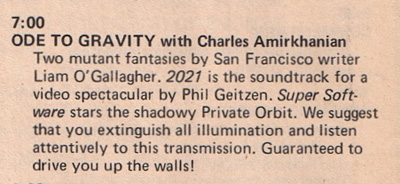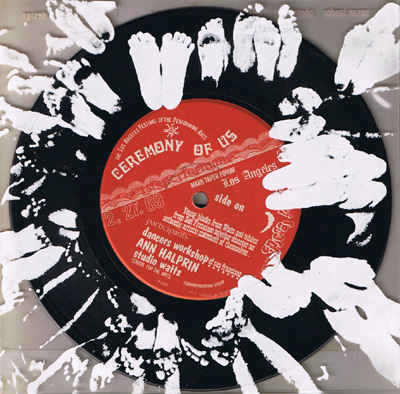 |
|


Excerpt from KQED Programming Guide,
Ode to Gravity, 1970 |
ODE TO GRAVITY
Word-Tape works of Liam O'Gallagher (March 25, 1970)
Listen to Audio:
A program of word art by San Francisco intermedia artist Liam O'Gallagher. O’Gallagher, for many years a painter, studied with Hans Hoffmann. In the late 1960s he became very active as a leader in the Bay Area of activities in the field of event art. His book of concrete poetry, “Planet Noise”, was published by Nova Broadcast Press. In this program O’Gallagher introduces sound poems produced especially for this original KPFA broadcast.
ODE TO GRAVITY
New Works of Liam O'Gallagher (July 28, 1971)
Listen to Audio:
Three mutant fantasies by San Francisco writer and visual artist Liam O'Gallagher. "2021" is a reply to Philip Geitzen's question concerning whether science fiction will be science fact in 2021. It was the soundtrack for a Geitzen video piece premiered at the Philo T. Farnsworth Memorial event held at the Palace of Fine Arts in San Francisco in June of 1971. "Super/Software" is a cut-up text which will appear in O'Gallagher's The Blue Planet Notebooks, to be published by the San Francisco underground magazine, Organ. "Past/Future Time" is a cut-up which includes material from a record found in the elevator at 205 West 57th, it could be a so-called "artifact" from a future time, perhaps 100 to 125 years from the present.
|

Record featuring Ceremony of Us soundtrack,
designed by Liam O'Gallagher

Ceremony of Us record, front
|
In 1970, Liam O'Gallagher combined performance, chance, and technology to create surreal, and often humorous sound experiments that included Border Dissolve in Audiospace. The work, which was broadcast on KPFA-FM, involved telephone operators on various sides of state and national borders.
"In 1969, soon after the presentation of A Ceremony of Us, I was hired as Music Director at the radio station KPFA,” Charles Amirkhanian recalls. “I went to my friends and told them if they had some ideas and wanted some airtime, I could make it available. We started creating these on air ‘events,’ which were not just something you listened to – instead the audience was urged to do something in response. Liam was one of the first who did an event on the radio. Border Dissolve in Audiospace was a work that presented a number of technical challenges. Richard Friedman was at the controls and he had all of the telephones being recorded and figured out how to collage all of the conversations with the operators in real time while Bob and Liam made the calls. It ended up being very popular with our audience. People would call and request Border Dissolve in Audiospace… or, more correctly, would say 'could you play that thing with the operators?'"
As with many of Liam’s events, the piece was carefully described, so that it could be replicated by others:
“Border Dissolve can be performed by any two people in the privacy of their own telephone. Two individuals are ‘initiators’ and any number of ‘operators’ can play. One initiator calls one side of the border and the other calls the other side of the border, and they each start from opposite ends of their chosen border and engage various operators in various areas along the border, inquiring about time, weather, zoo listings, general information, and other toll-free numbers. There is no time-limit. Each initiator calls along his or her side of the border until the opposite end of the border is reached. If desired the calls are taped or broadcast via radio thus widening the audiospace. The event is completed when each initiator has reached the opposite end of the border. Audiospace borders are then declared dissolved. In this manner, even the borders of islands can be dissolved. Or, for that matter, so can the borders of planets be dissolved. What is the area code for Mars? Sufficient dissolution of borders in audiospace can create a dissolution of borders in three-dimensional space. Pick a border, any border, dissolve it. Any number will do.”
|
Another audio work, People's Opera aka Aerosol/or the Computer That Couldn’t Hear: An Inter-Media Opera, featured nine transistor radios (four tuned to FM stations and five to AM stations), a telephone system, and soloists on tambourine, flute, oboe, and French horn. Liam’s notes on the presentation read:
“The ‘conductor’ signals the operators of the radios to approach the microphones or recede from them. Soloists play according to any predetermined plan. Two soloists play in the studios and two phone into the studios and play their parts through the phone system.
The ‘scorer’ works from the main broadcast control room of the radio station and controls the mix and effects of the various inputs. He determines the final signal or output.
The ‘orchestra’ selects their stations and maintains them throughout the performance. If possible, stations should represent various genres or segments of the community, such as Chinese language, soul, Spanish language, rock, popular tunes, spiritual- and Bible-toned stations.
The time limit is agreed upon in advance by the participants. Drop out, turn around, tune in.”
This piece was performed by broadcast on KQED-FM the same year, for an estimated audience of 25,000. Tapes by Robert Moran and Charles Amirkhanian were used as part of the mix. FM performers were Philip Geitzen, Billy Kettleman, Robert Rheem, and Steven Solberg. Soloists included Jeff Beach, Steve Bennett, and Tom MacDonald. |
|
|
 |
|